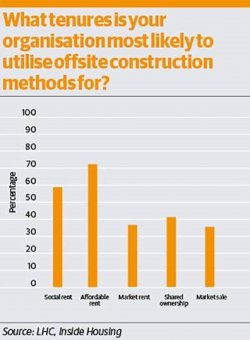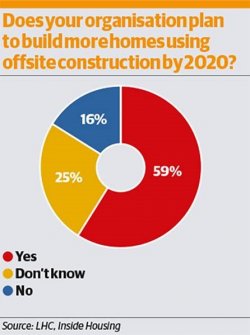Are social landlords starting to embrace offsite construction? Inside Housing and LHC carried out a survey to find out.
Decades of undersupply has seen a housing shortage lurch into a full-blown housing crisis in recent years. But social landlords are leading the rebuilding effort.
For example, housing associations have committed themselves to £8.7bn of development spend in the period July 2017 to July 2018, according to the Homes and Communities Agency’s most recent quarterly survey.

However more needs to be done, with housing supply not predicted to match housing need in the near future. Although there isn’t a silver bullet, one potential solution that could enable the sector to make headway in housing delivery is offsite construction.
The government’s Fixing our Broken Housing Market White Paper, published earlier this year, said that offsite manufacturing techniques could be a catalyst for change in the sector.
Inside Housing and LHC sought to find out to what extent modern methods of construction (MMC) are being embraced by social landlords. We launched a survey of housing professionals, asking a series of questions about their organisations’ approaches to offsite construction. A total of 96 respondents took part and the results paint an interesting picture.
First, it is clear that offsite delivery is still in its infancy across the sector. Only 41% of respondents said that their organisations were planning to develop any homes in the next 12 months utilising methods of offsite construction.
Nearly a third (30%) said their organisation’s development programme in the next year would contain between 1-10% homes built using offsite construction measures, but few (11%) were planning to develop more than 10% of their total pipeline using MMC.
Given that 61% of respondents plan to build more than 100 homes in the next year, it is still only a relatively small number of homes which are being developed using offsite methods.
Increase in offsite construction
But that picture looks set to change during the next few years. When asked whether their organisation was planning to increase the number of homes it builds using offsite construction within the next three years, 59% of participants said they were, with just 16% stating their organisation had no plans to do this.
By 2020, 51% of respondents expect their organisations to be developing between 1-30% of their total homes using offsite, whereas a further 10% expected to be delivering between 31-100% of their homes using offsite construction.
So how can the sector start to promote greater use of offsite technologies? We asked participants what the barriers were to their organisation taking up offsite methods of construction.
A lack of information and understanding about offsite was cited by almost half (48%) as an obstacle.
“People believe they’ve got a lack of information and don’t know how to go about it,” explains John Skivington, director at LHC. “I think a large proportion of those people who aren’t planning to build with offsite would be keen if they were clearer about it.”
The data backs up Mr Skivington’s viewpoint that the sector is supportive of offsite but just isn’t sure where to start.
More than three-quarters (79%) of participants believe offsite techniques will either be ‘important’ or ‘very important’ in delivering the number of new homes the UK needs.
John Carleton, executive director of property investment at 39,000-home Orbit, said his organisation is “pretty sold” on the concept of offsite construction and expects it to be part of what the association delivers in the future. But Orbit has yet to commit to a particular target because the organisation has yet to make a final decision about which solutions it plans to utilise.
“At the moment we’re spending quite a lot of time with several offsite manufacturers to talk to them about the product, about the pipeline for the product, about the manufacturing capabilities and how it fits into the sorts of environments that we will be building homes in,” he says.
The reasons why landlords are increasingly looking to offsite construction are clear.
More than half (58%) said that the primary reason they were planning to increase their offsite delivery was to speed up how quickly they could deliver new homes. Build speed compared with traditional methods of construction was cited as either ‘excellent’ or ‘good’ by 82% of participants.

There is also an acceptance from respondents that offsite construction can offer greater certainty around quality compared with traditional construction methods. Almost two-thirds (65%) took this view.
Cost challenges
But there remain challenges around cost. Thirty-nine per cent say that it is too expensive, with 44% citing a lack of funding from government to incentivise uptake as a barrier to entry.
Tina Barnard, chief executive at 5,000-home Watford Community Housing (WCH), says her organisation is planning to ramp up delivery of new homes through offsite during the next few years.
The challenge for WCH is around being able to maximise the number of homes which can be delivered in the shortest time possible.
She explains that most offsite factories are based north of the M1/M6 corridor meaning that the association is currently unable to make the most of the potential offsite can offer the organisation.
“Swan Housing has its factory in Basildon and clearly its argument for having it on its estate is that it will allow it to have throughput during the day, rather than just being able to travel at the dead of night because that’s the only time the motorways are clear.”
To overcome this challenge, Ms Barnard, who is also on the board of the Hertfordshire Local Enterprise Partnership, is exploring the viability of setting up an offsite factory in the region: “What I’m trying to put together with colleagues in Hertfordshire and nearby counties is – can we work together to establish a factory in the area?”
For Ms Barnard, there’s a need to move away from traditional costing models and to think differently about the provision of offsite housing.
“The argument for offsite construction needs to be that you’re going to have fewer defects and your maintenance is going to be less throughout the life cycle of the product. Once you establish that correlation, it becomes more affordable,” she concludes.
Original link - Inside Housing









